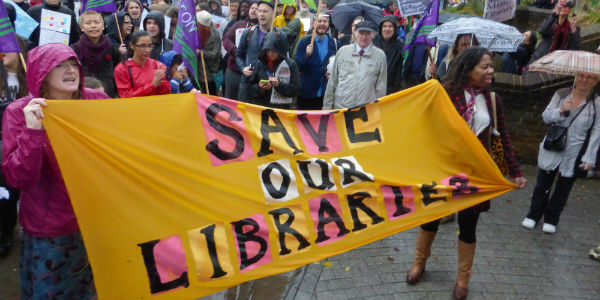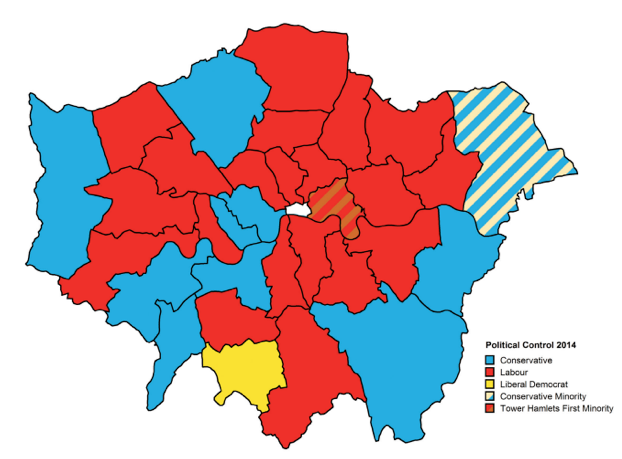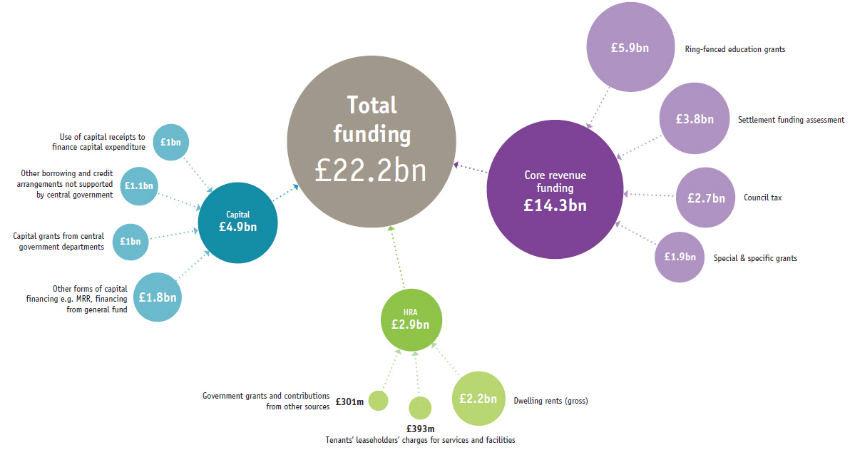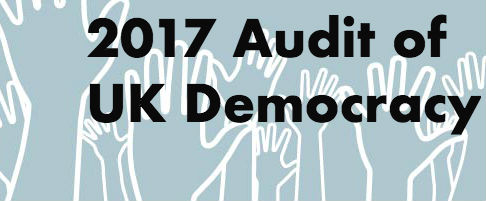Audit 2017: How democratically organised and effective are the London boroughs in serving the capital’s population?
Within London the 32 London boroughs undertake most local services provision and planning, and play a major role in shaping the capital’s evolution. As part of our 2017 Audit of UK Democracy, Tony Travers looks at how well they fulfil their roles.

A protest against the closure of libraries in Lambeth, 2015. Photo: Steve Eason via a CC-BY-NC-SA 2.0 licence
This article was published as part of our 2017 Audit of UK democracy. We have now published: The UK’s Changing Democracy: The 2018 Democratic Audit with LSE Press, available in all ebook formats. You can download the whole book for free, and individual chapters, including a fully revised version of this article.
What does democracy require of London’s borough councils?
- Elected politicians should normally maintain full executive control of local government and the public services that councils are required or empowered to deliver. In the London system, there are two tiers of sub-national government, the 32 boroughs (and the City of London) and the Greater London Authority (the GLA, consisting of a Mayor and Assembly). The latter has no supervisory responsibility over the former.
- Boroughs should represent local and neighbourhood interests whereas the GLA represents London-wide ones. The lower tier authorities should be the focus of local democracy in the delivery of municipal services and leadership.
- Individually and collectively, London’s councils should not only deliver publicly-accountable services but also, in effect, act as a democratic counter-balance to the city-wide power of the Mayor.
- Councils should have accountable, effective and responsive leadership, with an understanding of the needs of all their citizens and acting in ways responsive to public opinion.
- In addition to their representative role on behalf of their constituents, the non-executive members of the London borough councils should undertake oversight and scrutiny functions so as to provide strengthened performance and accountability.
- London’s borough government should be consistently and predictably funded in such a way as to provide a link between raising of resources and their use, while also being sufficient to deliver legislatively-required public services.
- London councils should be a stable part of UK local government, with some quasi-constitutional protection against ad hoc, inconsistent and/or partisan interventions from other tiers of government.
In common with local authorities throughout England, the London boroughs’ responsibilities for service delivery have been much reduced, but they have become far more active as local economic development institutions. Local government now has only residual responsibilities over education, for example, where once this was their biggest spending function. Borough councils in the capital each have between 45 and 70 councillors, with significant disparities in the numbers of registered voters (and, separately, total population) per elected member. Councillors stand for election every four years (when all seats are up for election). There have been 14 of these elections since the boroughs were created in 1964.
Each of the 32 councils is generally led by a cabinet, consisting of a sub-group of the elected members chosen from either the majority party, or a coalition/combination of two minority ones. In four cases (Hackney, Lewisham, Newham and Tower Hamlets) there is a separately-elected executive mayor who holds executive power.
The boroughs and the City are relatively powerful units of sub-national government in London. Their total budget is broadly twice the size of the GLA’s, so the arrangement can be characterised as a bottom-heavy two-tier system.
Recent developments
As with local government elsewhere in England, London borough elections use the first-past-the-post (‘plurality’) voting system. They last took place in May 2014, on the same day as the European Parliamentary elections. Labour won 20 councils (up by 4), the Conservatives 9 (down by 3), and the Liberal Democrats 1 (down by 1), with 2 ‘no overall control’ results. The City of London largely eschews party politics, and holds its elections every four years on a different cycle. The most recent occurred in March 2017, with one of the major national parties (Labour) gaining an unprecedented five seats.
Turnout in the 2014 borough contests averaged 39 per cent, down from 62 per cent in 2010, when the borough elections were held on the same day as the general election. In years unaffected by general elections, the highest-ever turnout was 48 per cent in 1990 and the lowest was 32 per cent in 2002. Partly reflecting the multiparty character of European elections, some nearly 7,000 more candidates stood for election in 2014, up by 115 candidates on the 2010 total, and 437 more than in 2006.
Chart 1: Political control of London boroughs after the 2014 elections

Source: GLA.
The central government appointed Commissioners in late 2014 to take over the government of Tower Hamlets, to support the council improvement and to ensure transparent and open governance. In particular, the commissioners assumed direct responsibility for the borough’s grant-giving. In 2015 Mayor Lutfur Rahman’s 2014 election was declared null and void by the Election Court because of electoral fraud within the terms of the Representation of the People Act, 1983. Rahman was disbarred from public office until 2021. Subsequently, a new mayor was elected and the commissioners have been stood down.
In June 2017, a disastrous fire occurred at Grenfell Tower in Kensington and Chelsea borough, killing at least 80 people, and with 255 people being rescued. The consequences of the fire and a woeful aftermath in terms of meeting survivors’ needs included the (forced) resignation of the borough’s chief executive, followed later by the Conservative council leader and deputy leader. In the immediate aftermath of the disaster, a joint (‘Gold Command’) arrangement of other borough chief executives and officers assumed control of recovery and administration. The government announced that a task force (with advisory not executive powers) would be appointed to assist the longer-term recovery from the fire and its impacts. Kensington and Chelsea’s new Tory leader admitted that trust in the council had been seriously damaged by the incident and the council’s subsequent response.
Strengths, Weaknesses, Opportunities and Threats (SWOT) analysis
| Current strengths | Current weaknesses |
|---|---|
| In many boroughs there is effective competition between two or more parties, with the real chance of a change of control at forthcoming elections. The Conservatives, Labour and the Liberal Democrats are active in every borough, while there has been some growth in minor parties in recent decades. In 2014, over 26 per cent of the votes cast in the borough elections went to parties other than the ‘big three’, though this resulted in the ‘others’ winning only 3.4 per cent of seats. | There is far less democratic competition in some boroughs than others. In Newham and Barking & Dagenham a single party holds all the seats on the council. In Lewisham and Islington the majority party holds all but one and in Lambeth all but four. The number of minority party councillors on a number of councils is below 10 per cent of the total. The make-up of the electorate, ward boundaries, the fragmented opposition and the first-past-the-post voting system together ensure that in Barking & Dagenham Labour can win all seats with around half the votes cast (as few as 47.5 per cent in 2010). In 2006, which was a bad year for Labour, the party won 54 out of 60 seats with 41.9 per cent of the vote. There are other boroughs, such as Westminster and Kensington & Chelsea where there has also never been a change of control, though there is a sizeable opposition in both. |
| Turnouts at 38-39% have been around 5 to 6% higher than at the turn of the century, but below the levels of the politically-charged 1980s and early 1990s. Political controversy seems to drive up turnout. | Although turnout was up slightly in 2014, the overall level is just on a par with other UK local elections, and low by international standards In 2014, the turnout across Kensington and Chelsea was just 30 percent and as low as 24 percent in one individual ward. |
| Stability is a key attribute of the London boroughs. They have survived with virtually the same boundaries and many of the same service responsibilities for 52 years, they are now the oldest municipalities in the UK. Virtually all other public providers have been reorganised more frequently. Despite their lack of any formal constitutional protection, the London boroughs have proved resilient within a UK government system which is subject to regular administrative ‘churn’. The City of London, an exception to virtually all rules, is almost a thousand years old. | The City of London’s democratic position is anomalous and has been for decades. Its franchise includes business votes, a characteristic which was unique in modern sub-national government until business improvement districts came into existence in the 2000s. The latter are business-led, but have access to non-domestic rates as a revenue source. In addition, many larger London businesses are now required to pay a supplementary local rate to fund the Crossrail project. |
| Local responsiveness is perhaps the single most important virtue of London boroughs and their councillors. There are 1861 councillors in London (compared to 73 MPs and to 25 Greater London Assembly members, only 14 with constituency roles). So London borough wards cover an area or neighbourhood which is small enough to allow easy access to elected representatives. In a city as large as London (1572 sq km) residents have a need for both local and city-wide voice. Borough councillors make locally-sensitive representation possible. | The processes that political parties use to choose candidates are not easy for the wider public to understand, though this issue is not unique to London. Parties are private organisations which have their own processes for selecting candidates for all types of election. The closed nature of party selections may from time to time encourage ‘entryism’. Here a sub-set of party members within a party become able to choose candidates by surviving long meetings, procedural struggles and other ways of operating that discourage wider participation by the wider local membership. |
| London is by far the most diverse part of the UK. The most recent census of the city’s councillors (in 2013) suggested nearly 16% were from black and minority ethnic communities, and this share probably increased in 2014 – in line with the 2017 general election when just over 16 per cent of London’s MPs came from BME backgrounds. Only a third of London councillors are female. | There have been examples of electoral fraud in a number of British councils in recent years including, notoriously, in Tower Hamlets. Although London elections are generally well-managed and clean, there have been accusations of malpractice, though there have been very few examples of proven fraud. Since the Tower Hamlets case greater efforts have been made to monitor electoral registers, postal voting and (with police assistance) polling stations. |
| The boroughs are capable of representing themselves and their democratic position within UK government in negotiations with the Mayor and Whitehall. A jointly-funded representative body, London Councils, acts both to safeguard borough interests during the passage of legislation and in lobbying for greater devolution, as well as being the collective voice for boroughs in relation to national and city-wide government and to other institutions. | The small size and multiplicity of London boroughs are criticised from time to time. Thirty two boroughs seems a large number of authorities for a relatively small geographical area. Some critics have suggested a move to 14 (the number of Assembly constituencies) or even five ‘super boroughs’. From a democratic point of view, reducing the number of boroughs would inevitably reduce the number of elected representatives, and cut the possibility of access by the public. Five boroughs would mean each having an average population of 1.8 million, almost twice the size of Birmingham City Council. If boroughs were that large, some form of ‘parish’ or ‘community’ council would doubtless be required, thus creating three tiers of sub-national government within London. (Some shire areas already have county, district and parish councillors, which can be seen as complex). In democratic terms, any reform of London borough government would need to take access and local accountability into account. |
| Since the abolition of the Audit Commission, there have been no objective council-wide assessments of London boroughs’ performance. But there has been little evidence to suggest that London boroughs are disproportionately susceptible to management, financial or service failure. Apart from the cases of Tower Hamlets and Kensington and Chelsea discussed above, both one-party dominated for long periods, there have been no examples of significant difficulties affecting individual councils. Given the scale of revenue expenditure cuts demanded of many London boroughs since 2010 (see ‘Weaknesses’), their performance can be seen as remarkably good in the circumstances. | Tax raising by the London boroughs has been centrally-constrained since rate capping started in the mid-1980s. From 2010 onwards a number of boroughs have had their revenue spending reduced by between 35 and 45 per cent in real terms - a far greater cut than almost all other parts of the public sector. Such sharp cutbacks required boroughs to protect some services, such as social care, while allowing others to take even deeper cuts. Official statistics show central administration, roads and planning have faced reductions of 50 per cent or more over seven years. The National Audit Office has reported on the financial sustainability of English local authorities as a whole, explaining that the scale of change is unprecedented. Government plans show further reductions in non-social care spending at least till 2020. It is hard to see how London boroughs’ core capacity cannot be affected by reductions on such a scale. |
| Future opportunities | Future threats |
|---|---|
| The boroughs and the Mayor have been jointly negotiating with central government over a further package to devolve powers over skills, employment, criminal justice, housing and health to London. The sense that devolution is a ‘process not an event’ has created dynamism which was reflected in the London Finance Commission report of January 2017, which argued for fiscal devolution to the boroughs and the Mayor. | Brexit is a potential threat to the economic development and stability of a number of London boroughs which have in recent years had to harness major projects in order to pay for new local facilities and services. Any abrupt, ‘cliff-edge’ departure from the EU might adversely affect the tax base of London authorities, especially if and when more taxations powers are devolved. |
| As the primary planning authorities for the capital, the boroughs have the chance to reduce any short-term impact of Brexit by adjusting their policies to accommodate any shocks that emerge as the UK leaves the EU. More generally, London councils have significant freedom to use planning and regeneration policies to make good the lack of central government funding for investment. | Any recession, whether or not linked to Brexit, also would threaten the boroughs’ capacity to deliver large numbers of new homes. The softening of the London property market during 2016 and 2017 will change the economics of many boroughs’ regeneration plans. |
| Housing supply is linked to the planning system. Given co-operation involving the Mayor and Whitehall, it would be possible to increase the numbers of both affordable and total homes available in London. There is growing central government pressure on councils, land owners and the development industry to increase housing supply. More than any other part of government, the boroughs could create the conditions needed to deliver a rising number of new homes, though such an outcome would require additional borrowing freedoms and greater use of resources created by selling of social housing. | The fallout from the Grenfell Tower disaster will inevitably include the need for many London councils to spend substantial amounts of money on improving the safety of their high rise housing blocks. Whether central government will assist in funding of these upgrades remains unclear. Boroughs affected will face short- and longer-term costs that may run into billions of pounds. There is a risk to the availability of social housing and also to the maintenance of buildings other than those affected by post-Grenfell requirements for improvements. |
| The boroughs can assist the Mayor with the delivery of the Crossrail 2 regional railway. It will require significant amounts of development on sites within a number of boroughs from Enfield and Waltham Forest, across inner and central London, to Sutton and Kingston. Again, the creative use of the planning system will be essential to both tiers of government if they are to generate resources for improved services. | There is always a risk that the government will initiate a reorganisation of the boroughs as a solution to a problem - such as loss of capacity due to revenue spending reductions; or to respond to failings revealed by the Grenfell Tower public inquiry. All local government in the UK is almost-permanently under threat of some potential reorganisation. |
How the boroughs work and what they do
Since their creation in 1965 to today, the London boroughs have survived (while the former Greater London Council was abolished by the Thatcher government in 1986), partly because their service responsibilities matter to local residents, even though they have altered a lot over time. The boroughs run social care, environmental services, most roads, public health, part of social housing, some services and oversight for local schools, some special needs transport and the administration of elections. Council leaderships (generally a mayor or cabinet) make policy which is subject to voting and scrutiny by the whole council. In all but two boroughs there is a majority administration of one party (see Chart 1 above). Service delivery is the responsibility of non-political professional officers who are appointed by the council.
Two-tier government
For resident Londoners and businesses, the borough is the unit of government responsible for most local services. The Mayor of London and the London Assembly have explicitly separate responsibilities (see here). There is some overlap: boroughs must fit their local plans within the Mayor’s overall London Plan, while the Mayor is responsible for allocating resources to support affordable housing and can lead policy but does not have a delivery role. The boroughs, on the other hand, work in partnership with City Hall to deliver homes. The Mayor’s agency, Transport for London, allocates some transport funding to boroughs.
It is relatively easy to understand for the public to understand the differences between the boroughs’ responsibilities and those of the Mayor. There is probably greater confusion amongst citizens on how the boroughs’ responsibilities for social care and link to the NHS health care, supervised by central government. Failings or deficiencies in the joined-up care of older people can easily lead to finger-pointing between central and local government, as across England.
In the 17 years since London-wide government was restored, the boroughs have come to accept the Greater London Authority, particularly the office of mayor, as a legitimate expression of metropolitan democratic needs. There is no borough-initiated campaign to reform the GLA, though there have been concerns expressed by some borough leaderships about the London Assembly. From time to time, individual boroughs will disagree with the Mayor of London about issues such as planning policy or house-building. But there is an acceptance that there are two legitimate spheres of sub-national government within London, which will disagree from time to time, for good democratic reasons.
The capacity of each tier of London government to represent different interests: ‘local’ and ‘metropolitan’ is, in effect, part of a de facto constitutional settlement for the capital that balances citizens’ own different needs. Despite the lack of a formal UK constitution or a London city charter to mediate between the two tiers of the capital’s government, relations are overwhelmingly managed effectively.
Financial dependency and budgets
In common with other UK local authorities, the boroughs are required to produce a balanced revenue (ie day-to-day) budget each year. Only capital expenditure projects can be funded by borrowing, and only so long as it is consistent with an official ‘prudential code’.
Chart 2 below shows that over four fifths of revenue expenditure is funded by government grants or re-distributed business rates (still centrally controlled). Less than 20 per cent of revenue spending is funded by the local council tax. The latter is effectively capped at a 2 per cent increase per annum, and to raise more a council would have to win a local referendum. The Conservative governments since 2015 have encouraged centrally-determined increases in council tax to pay for additional social care expenditure. (The government had plans to allow councils to retain 100 per cent of their non-domestic property tax income from 2020, though the result of the 2017 general election appears to have reduced the chances of this reform taking place). Capital expenditure represents just under a quarter of all London boroughs’ expenditure and is also partly grant-funded, though to a significantly lesser extent than revenue spending.
Chart 2: Total funding and expenditure, London boroughs (2015-16)

Source: London Councils
Conclusions
London’s local government is stable and effective. Despite very large reductions in centrally-set funding in recent years, London boroughs have been able to continue to deliver effective services and to regenerate former industrial parts of the city. Public satisfaction scores are generally high. Managing such a massive and complex city is a daily challenge, suggesting that this is one of the better-functioning parts of UK government. Stability has allowed politicians to concentrate on service delivery and regeneration.
The boroughs represent a long-established and accessible element in the government of a very large mega-city. With an average population of 275,000, London boroughs are large municipalities by international standards. Two outer boroughs are forecast to have populations in excess of 400,000 by the early 2020s. The scale of London makes it hard to envisage a system of government which did not include a local-scale tier capable of representing neighbourhood and community interests.
The variegated nature of London’s 8.8 million population means that there are differences that go beyond those related purely to a geographical area. But many groups of minority citizens are often concentrated within small numbers of boroughs. Looking ahead, a greater capacity for councillors to be representative of the many different communities represented in London is a decent goal. Expanding opportunities for neighbourhood involvement in local policy-making would be another.
However, there are inevitably clouds in this broadly benign picture. Occasionally events occur which are seen, rightly or wrongly, as systemic in their implications. Riots in 2011 were of this kind, as was the Grenfell Tower disaster. London remains an unequal city, though the centralised nature of UK government means the boroughs and the Mayor do not, even jointly, control many of the resources and powers necessary to deliver radical change. In a city as large and complex as London there is always the risk that an event will occur which will be interpreted as being totemic of broader governmental failure – a risk that London councils need to be mindful of.
This post does not represent the views of the LSE.
Tony Travers is a Visiting Professor in the Department of Government at the LSE and Director of LSE London. He is the author of London’s Boroughs at 50 (Biteback).






 Democratic Audit's core funding is provided by the Joseph Rowntree Charitable Trust. Additional funding is provided by the London School of Economics.
Democratic Audit's core funding is provided by the Joseph Rowntree Charitable Trust. Additional funding is provided by the London School of Economics.
[…] Source: How democratically organised and effective are the London boroughs in serving the capital’s popula… […]